So who was Frederick Selinger, and how did he fit into the family? And who was Fanny Selinger’s mother?
In Part I, I described the research I had done first with Val Collinson in 2014 and then separately with Shirley Allen during the summer and fall of 2015 to try and find the connections between all our various Selinger relatives. Through that research we had established with a fair degree of certainty that Julius and Alfred Selinger, who married two of my Cohen cousins, sisters Augusta and Fanny, were themselves brothers, the sons of Seligmann Selinger and Breinle Hofstadter. We had also established that Helena Selinger Auerbach, who had been Val’s great-grandmother, was a first cousin to Julius and Alfred and the daughter of Abraham Selinger and Rosalia Wilhelmsdorfer.
We also had established that Fanny Selinger Rosenthal, Shirley’s grandmother, was also a daughter of Abraham Selinger, but Shirley and I had not found any document that revealed whether her grandmother Fanny was a full or half sister to Helena and the other children of Abraham Selinger; we had not found her mother’s name or where she was born.
And I still didn’t know how Frederick Selinger fit into the question.
We also knew that Abraham Selinger had immigrated to England by 1871 because he appeared on the 1871 UK census with a second wife, Gali, along with several children: Sigfried, Helena, Cornelia, and Oscar. By 1881, Abraham had died, and his widow Gali was living with some different children: Morris, Flora, and Sidney, plus Oscar. Aside from Helena, who were all these children, and where were they born? I had no birth records for Cornelia, Morris, Flora, Sidney, or Oscar.
So by late November, we had many answers, but many questions remained.
Fast forward again to January 13, when I again heard from Shirley. She had received a copy of the marriage authorization for Fanny Selinger and Jacob Rosenthal from the Chief Rabbi in London. It confirmed that Fanny was the daughter of Abraham and that she was born in Hurben, but did not reveal her mother’s name. Although we did not have any new information, the new communication inspired us to try again to get answers to our primary questions: Who was Fanny Selinger’s mother? And how did Frederick Selinger fit into the family, if at all?
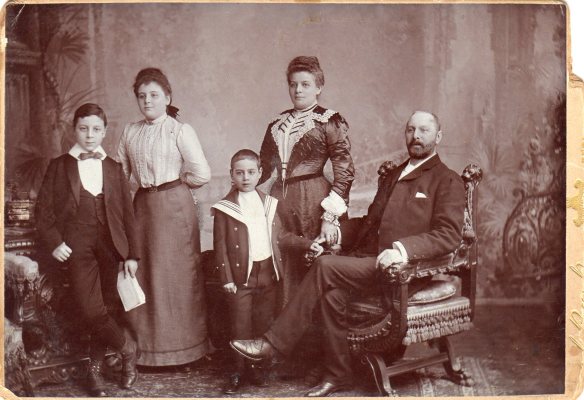
Fanny Selinger Rosenthal and her husband Jacob Rosenthal and children Gladys, Daniel, and Alfred
Courtesy of Shirley Allen
After reviewing everything we had, I decided to post on the German Genealogy group on Facebook for information about records in Ansbach , where Oskar Selinger had claimed to be born on his UK naturalization record. Although I was unable to find Ansbach birth records for the appropriate years, my friend Matthias did find two websites with information about Abraham Selinger in Ansbach: one, a website listing past and present tobacco businesses in Germany; Abraham Selinger was listed as the manager of Equity and cigar-tobacco factory in Ansbach from 1862 until 1871. Thus, it made sense that Oscar Selinger was born in Ansbach.
The second website was even more revealing. It was an Ansbach police report from 1870 reporting the arrest on May 31, 1870 of Abraham Selinger from Hurben, manager of a cigar factory, for fraud. Perhaps that is why 1871 was both the last date he had the cigar business in Ansbach as well as the first year he appeared on UK records.
But it also meant that the children I believed had been born to Abraham in the 1850s—Frederick, Fanny, Morris, Flora, and Sidney—were probably not born in Ansbach if Abraham’s business there didn’t start until 1862. So where were they born? Shirley continued to contact various offices in Germany, and I tried to think of new paths for research.
And then I had the best idea I’d had yet. While doing all this work with Shirley in 2015, I had somehow forgotten about my correspondence with Val Collinson back in 2014. Maybe Val had made some new discoveries or would have some new ideas. I wrote to Val on January 22, 2016, and now we had three heads working on the mysterious Selingers.
The emails started flying back and forth among the three of us, and it became clear fairly quickly that Val and Shirley had some relatives in common, that is, relatives they both had met or at least had heard of. I just sat back, enjoying the fact that I had brought these two cousins together. They both were descendants of Abraham Selinger: Shirley through his daughter Fanny, Val through his daughter Helena. We weren’t yet sure whether Helena and Fanny were full or half-sisters, but in any event Shirley and Val, who’d never heard of each other before and who live about 60-100 miles apart in the UK, are third cousins. I was thrilled that I’d brought these two wonderful family researchers and cousins together.
Shirley and Val both had lots of information about the marriages and descendants of some of the other Selinger siblings and also some wonderful photographs, but neither had any information about Frederick and neither was sure as to the identity of the mother or birthplaces of Fanny, Cornelia, Morris, Flora, or Sidney.
And then on January 29, 2016, the walls started tumbling down. Val found this on Ancestry:
Ludwigshafen?? Where was that? It’s a town very close to Mannheim. Could be this OUR Fanny? Val asked me to follow up because I have the broadest Ancestry subscription (All Access), and I was able to pull up a scan of the actual record. And not only did I find birth records for Fanny, I found them for three other children, all born to Abraham Selinger and Rosalia Wilhelmsdorfer, his first wife.
The four children born in Ludwigshafen were: Babetta, born in 1853, died in 1854; Flora, born in 1855 (later Flora Wallach); Fanny, born December 5, 1856; and Sigmund (later Sidney) born in 1858. We finally had a birth record for Fanny, and we knew now that she was in fact a full sister to Helena as they were both the daughters of Abraham Selinger and Rosalia Wilhelmsdoerfer. Val and Shirley were officially third cousins.
![Fanny Selinger birth record from Ludwigshafen Ancestry.com. Ludwigshafen, Germany, Births, Marriages, and Deaths, 1798-1875 [database on-line]. Provo, UT, USA: Ancestry.com Operations, Inc., 2015. Original data: Ludwigshafen Zivilstandsregister, 1798-1875. Stadtarchiv Ludwigshafen, Ludwigshafen, Deutschland.](https://brotmanblog.com/wp-content/uploads/2016/02/birth-record-of-fanny-selinger.jpg?w=584&h=775)
Fanny Selinger birth record from Ludwigshafen
Ancestry.com. Ludwigshafen, Germany, Births, Marriages, and Deaths, 1798-1875 [database on-line]. Provo, UT, USA: Ancestry.com Operations, Inc., 2015.
Original data: Ludwigshafen Zivilstandsregister, 1798-1875. Stadtarchiv Ludwigshafen, Ludwigshafen, Deutschland.
So that left three children whose birthplaces were still unknown: Morris, Cornelia, and, of course, Frederick. Since Morris and Cornelia were both born before 1862 when the Selinger family arrived in Ansbach and after 1848 when the family had moved to Mannheim, I assumed that they were probably born in Mannheim. The 1881 census recorded Cornelia’s age as 18, two years younger than Helena, whom they reported as twenty. But even English census records are unreliable. Helena would have been turning 22 that year; maybe Cornelia was really 19 or 20 and thus born in 1850 or 1851. The 1881 census said Morris was 28; he was probably born in 1852 since Babetta, the child who died in 1854, was born in 1853, in Ansbach. Cornelia and Morris would also probably have been the children of Abraham and Rosalia since there were four children born to that couple even after Cornelia and Morris were born.
So I went back to the Mannheim records because my initial search had been only for the years between 1853 to 1859; now I searched the set of records before it, dating from 1842 to 1852. And there they were, birth records for Cornelia (1850) and Morris (1852). And Helena (1849). All three were the children of Abraham Selinger and Rosalia Wilhelmdoerfer.

landesarchiv_baden-wuerttemberg_generallandesarchiv_karlsruhe_390_nr-_2862_bild_147_4-1229196-147
Birth record for Helena Selinger from Mannheim (center, left page)
So there are two birth records for Helena, one in Hurben, one in Mannheim. Go figure.
Meanwhile, Val found yet another document:
(I cannot understand why neither the Ludwigshafen nor the Ansbach registers showed up for me when I searched. Val has a magic touch with the search engine logic that I don’t have.)
I then retrieved the image of the actual document:
![Abraham Selinger family in Ansbach Ancestry.com. Ansbach, Germany, Lutheran Parish Register Extracts, 1550-1920 [database on-line]. Provo, UT, USA: Ancestry.com Operations, Inc., 2015. Original data: Ansbach Lutheran Parish Register Extracts. Digital images Tobias Brenner Collection.](https://brotmanblog.com/wp-content/uploads/2016/02/oscar-selinger-lutheran-register-ansbach.jpg?w=584&h=916)
Abraham Selinger family in Ansbach
Ancestry.com. Ansbach, Germany, Lutheran Parish Register Extracts, 1550-1920 [database on-line]. Provo, UT, USA: Ancestry.com Operations, Inc., 2015.
Original data: Ansbach Lutheran Parish Register Extracts. Digital images Tobias Brenner Collection.
Shirley, Val, and I had pretty much closed the circle on the children of Abraham Selinger. But despite all our efforts, we still had not found one record for Frederick Selinger. If he was born in 1856 as his passport application and his death certificate indicated, he should have been included with those children born in Ansbach. He would have been born around the time of Flora or Fanny, maybe even a twin of one of them. But he wasn’t there. And he wasn’t in the Mannheim records or the Hurben records.
So something did not make sense. Frederick was not the child of Abraham Selinger with either of his wives. I was convinced of it now. So who was he? What was I missing?
This is the part of the story where I just want to kick myself. I went back once again to the Hurben birth records and looked more closely at the children born to Seligman Selinger. There were nineteen of them. NINETEEN. Nine were born to Seligman and his first wife between 1835 and 1844. They all were born too early to be Frederick. Ten children were born to Seligman Selinger and his second wife, Breinle Hofstadter, between 1849 and 1866. There were five girls and five boys from that second marriage. The five boys were Heinrich (1852), Julius (1853), Sigfried (1855), Hugo (1860), and Alfred (1866). Julius and Alfred were the two who had married my Cohen cousins Augusta and Fanny. That left Heinrich, Sigfried, and Hugo. Could any of them be Frederick?
Sigfried. Hmm, I thought. That could have become Frederick, maybe?? But he was born December 29, 1855, and Frederick was born in December 1856, according to his US death certificate and his US passport application. So what, I thought? People lie! He made himself a year younger. The more I thought about it, the more I thought that Sigfried was Frederick. The disparity in the dates in December for his birthday (the death certificate said December 27, the passport application December 21) didn’t bother me either. Jews in Europe might not have known their birthday on a Gregorian calendar, only a Jewish calendar. Frederick might have just known that his birthday was close to Hanukkah and nothing more precise than that.
I went back to Ancestry to look at the records I had for Frederick. The earliest two—his 1880 marriage record and the 1880 census—list him as Fred, not Frederick. Fred could be a shortened version of Sigfried, couldn’t it? So I decided to search for Sigfried Selinger.
And I found this ship manifest from 1872:
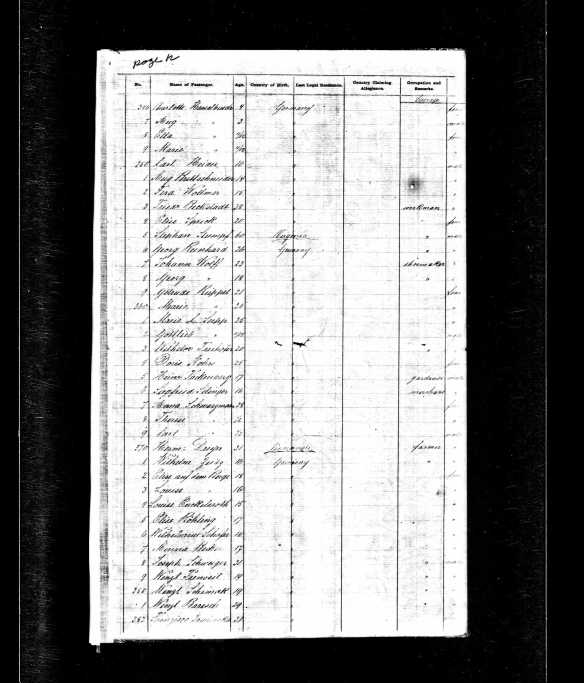
Siegfried Selinger ship manifest 1872 to Baltimore
The National Archives at Washington, D.C.; Washington, D.C.; Records of the US Customs Service, RG36; NAI Number: 2655153; Record Group Title: Records of the Immigration and Naturalization Service, 1787-2004; Record Group Number: 85
Siegfried Selinger, sixteen years old, arrived in Baltimore in June 1872, when Sigfried Selinger of Hurben would in fact have been still sixteen years old. I thought that this could very well be the man who became Frederick Selinger. Supporting this assumption was the fact that his marriage record states that he was from Baltimore and that he ended up marrying a woman from Washington, DC, so it would make sense that he would have entered the US through Baltimore, as his naturalization papers indicated. (They also say he entered the country in June 1871. People lie! People forget!)
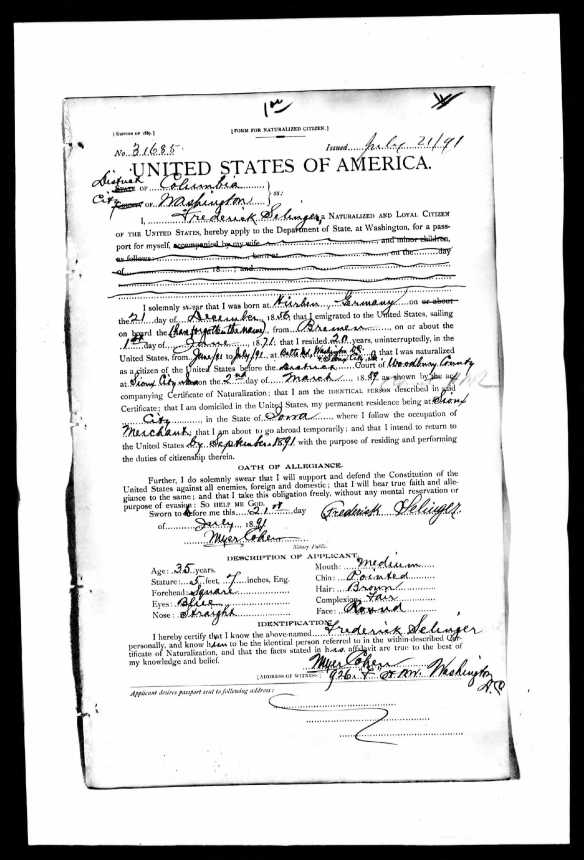
Frederick Selinger passport application
National Archives and Records Administration (NARA); Washington D.C.; NARA Series: Passport Applications, 1795-1905; Roll #: 378; Volume #: Roll 378 – 14 Jul 1891-31 Jul 1891
Description
Volume : Roll 378 – 14 Jul 1891-31 Jul 1891
And when I searched for Fred Selinger in Baltimore, I found two listings in Baltimore directories, one in 1875, one in 1878. I am quite certain I have found Frederick and now know that he was Sigfried Selinger, the son of Selinger Seligmann and Breinle Hofstadter. He was the middle brother to his brothers, Julius and Alfred, who followed him to the US in the following decade and married respectively the aunt (Augusta) and the sister (Fanny) of Frederick’s wife Rachel.
So why do I want to kick myself? Not only because I should have seen this much, much earlier, but because Ralph Bloch in fact told me he thought Sigfried could be Frederick way back in August, 2015. I’d forgotten that until I reviewed all the old emails to write this blog post. I probably saw his comment and forgot it or thought that I needed more proof. And I got caught up in searching for Fanny and the other Selingers and for some reason assumed Frederick had to be the child of Abraham. I could have so easily searched back then for Sigfried in the US and found what I found just this past week.
But actually I am so glad that I didn’t. Because if I had done that in August, I might never have continued searching and working with Shirley and Val. I might never have brought Shirley and Val together, third cousins who’d never known each other before. I would have missed out on all the fun Val and Shirley and I have had as we worked together to solve this mystery. That makes this all very worthwhile.
All this, you might say, for people who aren’t even my blood relatives? For people who happened to marry my distant cousins Rachel, Augusta, and Fanny?
It’s moments like this that I want to say, “We are all cousins. Our families are all entangled. And every person’s life, every person’s story is worth remembering and is worth memorializing.”

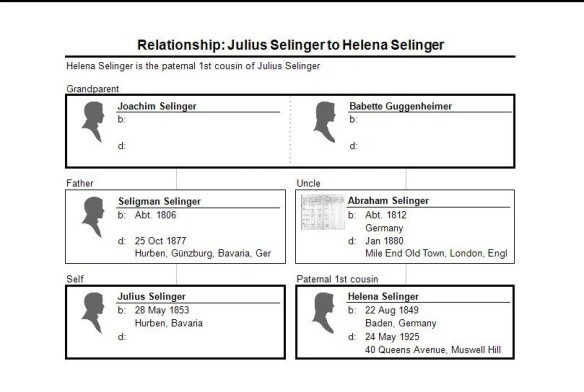


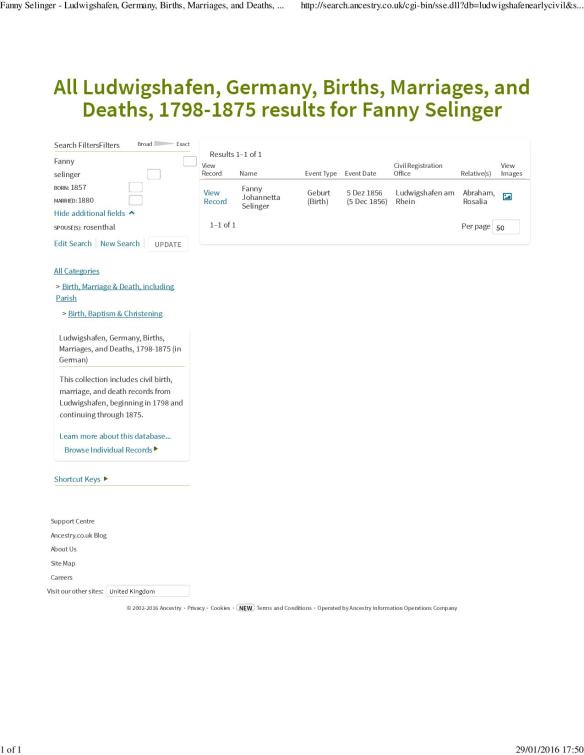

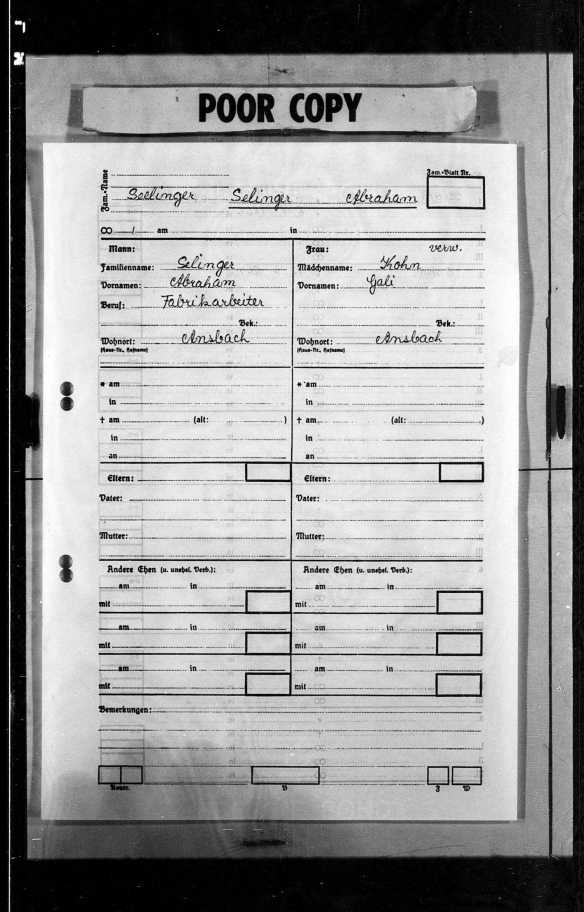

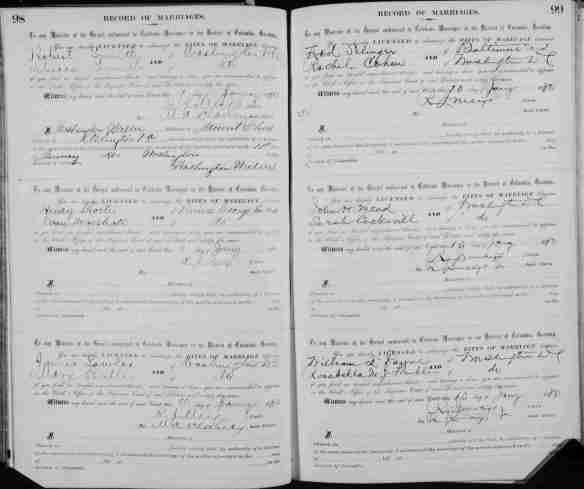
I had to smile when I read the last part. Very often I find myself so fixed on the search that I could also kick myself when I find someone has already gone through the same process. But in the end it feels good to have done the research on my own.
Val and Shirley’s roll in the second part of your search for Frederick make it even more special.
LikeLiked by 1 person
It is always fun working with others! And I always hear the Good Witch from the Wizard of Oz telling Dorothy that she could have told her about the ruby slippers’ powers at the beginning, but then she never would have learned what she learned. The journey is 90% of the fun!
LikeLiked by 1 person
So true Amy. 🙂
LikeLiked by 1 person
Mystery solved! And it is lots of fun to partner up with others when the opportunity presents itself. My mother always used to say “Two heads are better than one!”
LikeLiked by 1 person
And better yet—THREE!
LikeLike
For me this is wonderful, family history at its finest. I have really enjoyed researching with yourself and Val and had some great fun. Thank you for searching out Fanny and the other Selingers, they are not so mysterious any more! Am glad you told their story.
LikeLiked by 1 person
So am I. It was all around a fun experience, and I learned a lot. Best of all was working with you and Val!
LikeLike
I’m smiling at this post Amy. I’m so glad your mystery is solved, and that you’ve made and strengthened living family connections. And I love your last lines; so true!
LikeLiked by 1 person
Thanks, Su! I do truly feel that way.
LikeLiked by 1 person
Oh I love this! We are all cousins somehow right? We just have to get back to Noah to prove it. 😉 The family photo is lovely – the details are wonderful. I’m happy you found your answer.
LikeLike
Thank you! I do believe our histories are all intertwined and all part of everyone’s history.
LikeLiked by 1 person
Me too!
LikeLiked by 1 person
Oh, I hate when I do that–get information and forget I received it. There is just too much to process and until we have enough information to contextualize it’s easy to forget.
And, yes, all this for people who aren’t blood relatives. I find myself doing that, too. But truly, we ARE all cousins, and it’s all part of the larger fabric of what life was like in “those days.” Micro-history, rather than macro-history.
LikeLiked by 1 person
All that, plus the thrill of the search for answers that might actually be answerable. I love it all—the collaboration, the research, the history, the mystery. 🙂
LikeLike
Another great post Amy, and while I love looking at the beautiful old German records, I am glad I don’t have to try to read them. Your eyes must be much better than mine! 🙂
LikeLiked by 1 person
I sometimes look and can’t read a thing. Other times the words just pop out. Usually the names are somewhat recognizable. Plus I have help from those who CAN read German!
LikeLike
The ‘aha’ moments are remarkable, aren’t they? That instant when you smack yourself across the forehead and wonder why you didn’t see it months (or years) ago. I have a 2x great grandmother named Frances and I couldn’t find her for the longest time. When I first saw the photo of her husband’s grave and saw he was buried with Fredericka it hit me – Fredericka was Frances!
So glad you and your cousins have connected – that’s the cherry on top of the sundae!
LikeLiked by 1 person
Those are the moments when you both want to laugh at yourself and also cheer! One of the many rewards of genealogy research! Thanks, Debi.
LikeLike
Great Teamwork, Amy. I know what you mean about not putting the details together. While I was looking for my great grandmothers family details, I knew her mothers married name. At the same time I was also holding the details of another women with the same first name, along with her birth details. I should have seen the connection, but I didnt. It actually took me several years before I finally figured out that these two women were actually the exact same woman. I just needed to find the marriage record to prove it!! That was easily done. This revelation answered so many questions – and of course, opened several more!!!
LikeLiked by 1 person
Thank you, Francesca! I do love those aha moments, even if sometimes I also feel like slapping my forehead. And yes, every answer leads to more questions. I love it!
LikeLike